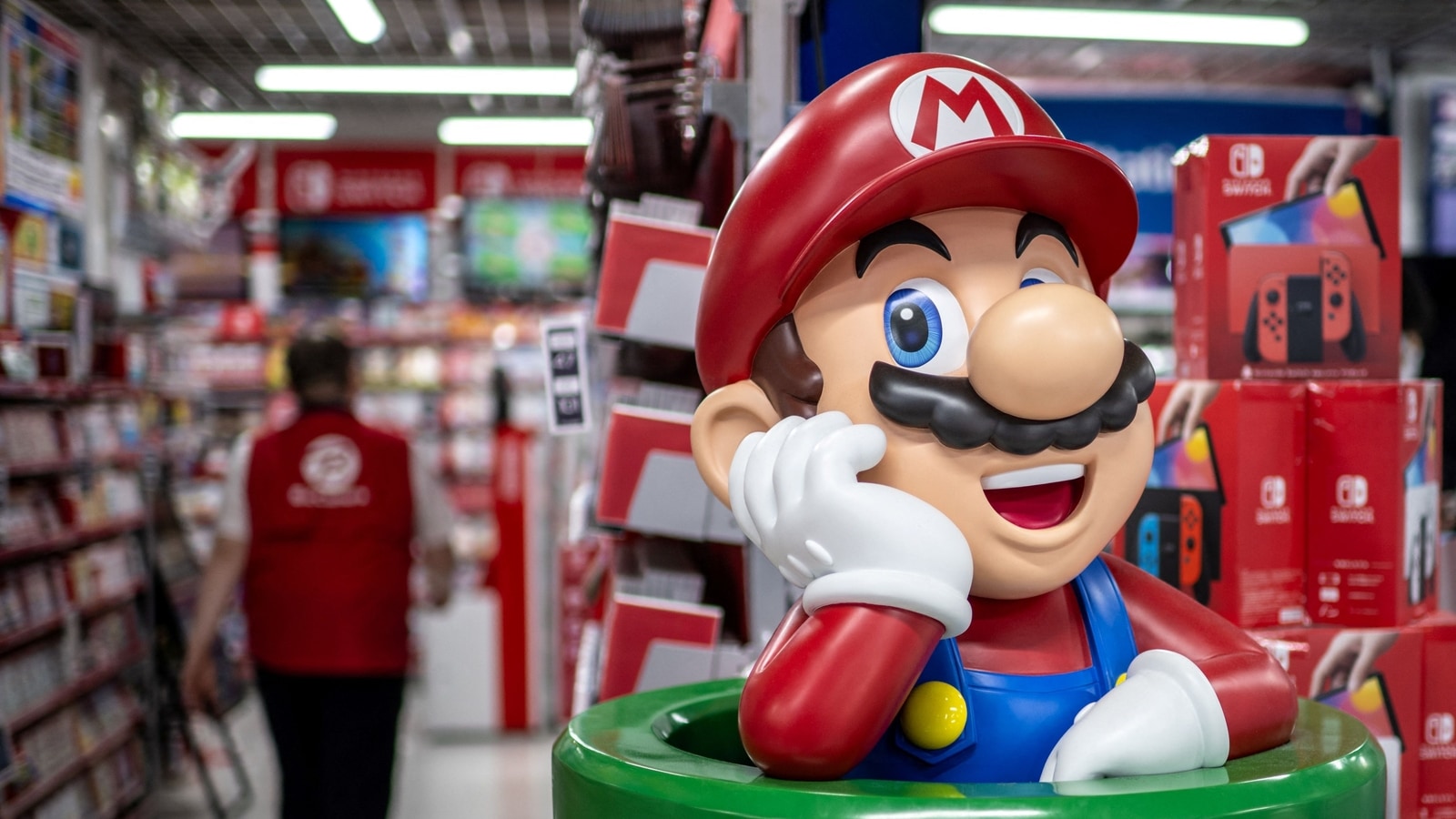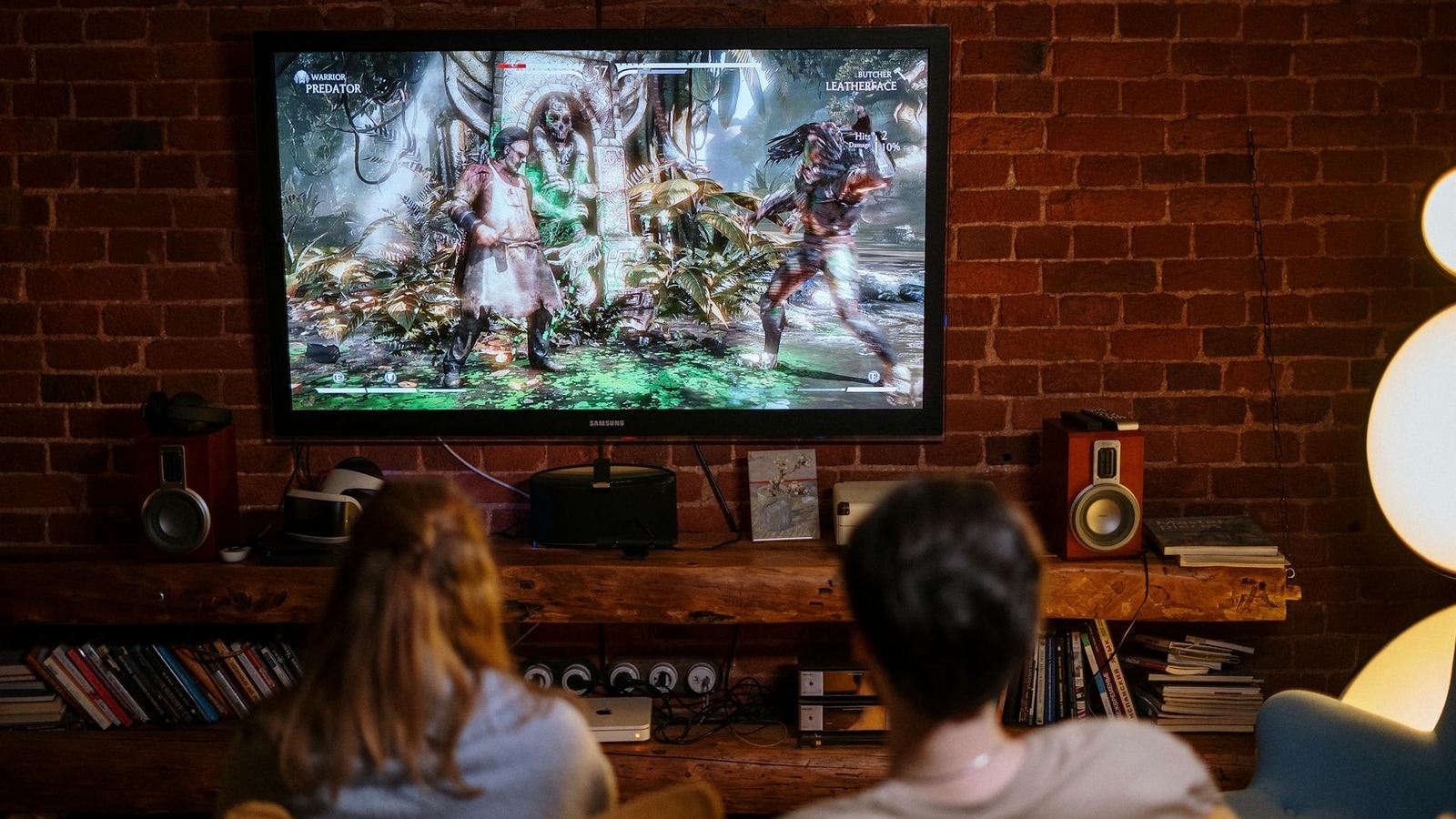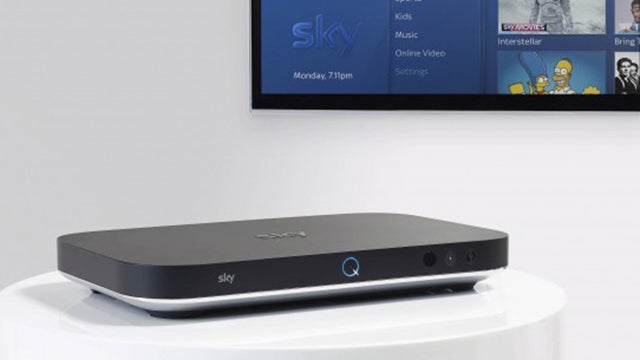Verdict
Technically it’s still the most advanced TV platform on the planet, but in a world of streaming, the newer Sky Stream or Sky Glass platforms may make more sense to most people. That said, the internet-free delivery, ability to record and store programmes for as long as you want, and the same great range of content can make Sky Q the right system for some people.
Pros
- Watch practically everything anywhere
- Powerful interface
- Recordings can be kept forever
- Lots of Ultra HD content
- HDR and Dolby Atmos
Cons
- Not cheap
- HDR support limited
- Dolby Atmos doesn’t work in apps
- Requires a satellite dish
Key Specifications
- Multi-room requires a Sky Q main box and one Sky Q Mini box
- Supports up to two simultaneous Sky Q Mini boxes and two mobile devices
- Ultra HD resolution (Sky Q), Full HD resolution (Sky Q Mini)
- Netflix, YouTube, BBC iPlayer and Spotify apps
Launched back in 2016, Sky Q was the company’s answer to the new-wave of streaming services, spearheaded by Netflix. Taking everything great about Sky TV, the company built a new multi-room system, so you could watch your live and recorded shows anywhere in the house, both on other TVs and on your phone.
Since it launched, faster internet speeds enabling higher-quality streaming services has seen Sky Q come under fire to the point that the latest products, Sky Glass and Sky Stream, ditch the need for a satellite dish completely. Offering more flexibility and a more straightforward installation, the new Sky services are probably a better fit for most people.
Yet, there are still some of us that can do with Sky Q: its main TV doesn’t need a broadband connection, it’s on-demand services can deliver 4K UHD regardless of internet speed, and it can store recorded programmes for as long as you like. Here’s what you want to know.
Design and boxes
- Your TV service where you want it
- Only the main box provides 4K
Although Sky Q can work on a single TV, the system really shows its worth when you opt for the Multiroom package, which is the focus of this review.
These packages begin with the main box, which acts as the hub for your system. As standard you get a 1TB box, but a larger, 2TB model is available for those who see themselves recording and downloading a tonne of content – although you’ll need to talk to a Sky Advisor to order one.
More than six years on since launch and the Sky Q box design remains impressive. Smooth curves and a simple front result in a box that looks great, but doesn’t draw too much attention. Compare it to the Virgin V6 box, which looks like a relic from the 1980s, and Sky has a clear design lead.
Boxes are still chunky compared to the more modern Stream device: there’s not much Sky can do about this, as it has to squeeze in satellite tuners and a hard disk.
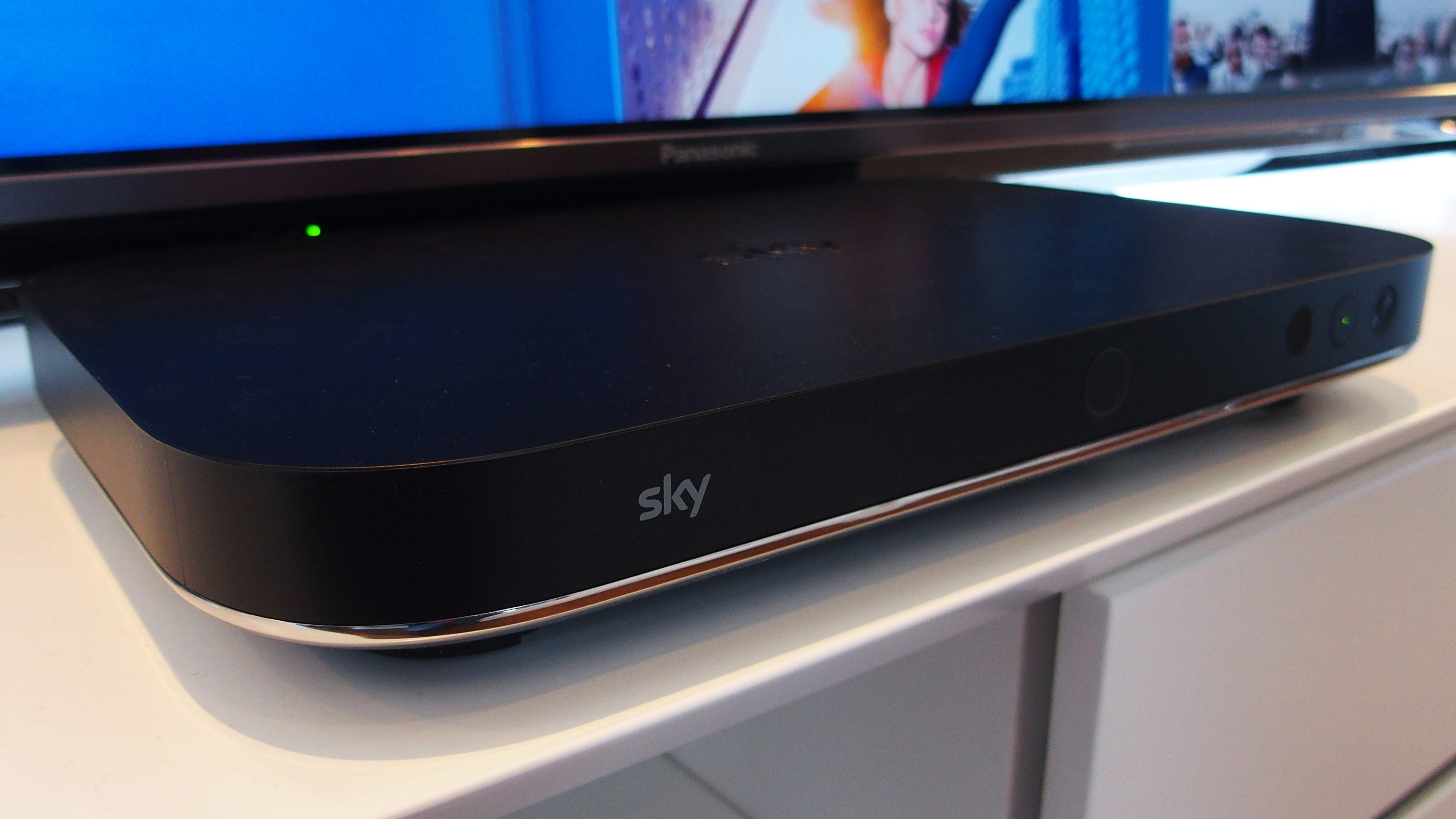
Sky Q really shows its worth when you add in extra devices, including Mini boxes that you plug into other TVs in your home. These stream live channels, on-demand TV and recordings from your main box, giving you access to your full Sky Q package from around your home. You can have up to two Mini boxes working simultaneously, although if you want more than one, then you’ll have to phone up to order.
Each Mini is a relatively small and neat-looking box. While the main Sky Q box is 4K compatible, the Mini boxes are HD-only. With faster wireless available today than when Sky Q first launched, I’d like to see Ultra HD Mini boxes – but it seems unlikely that we’ll get this, given that the main focus is now the new streaming services.
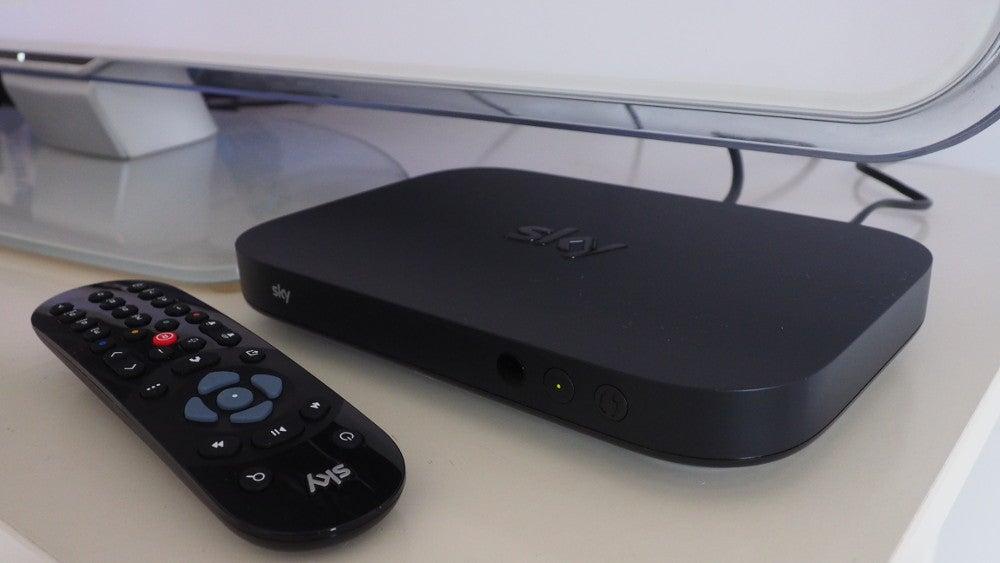
Beyond the physical boxes, you can use the Sky Go app on your phone or tablet. Provided your device is on the same network as your main Sky Q box, you can stream live channels, on-demand programmes and even download recordings from Sky channels (those bar BBC, ITV, and so on) for offline watching. Up to two mobile devices can be connected at the same time, in addition to two Mini boxes. Outside of your home network Sky Go works as normal, giving you live TV streaming (Sky channels online outside your home) and access to on-demand content.
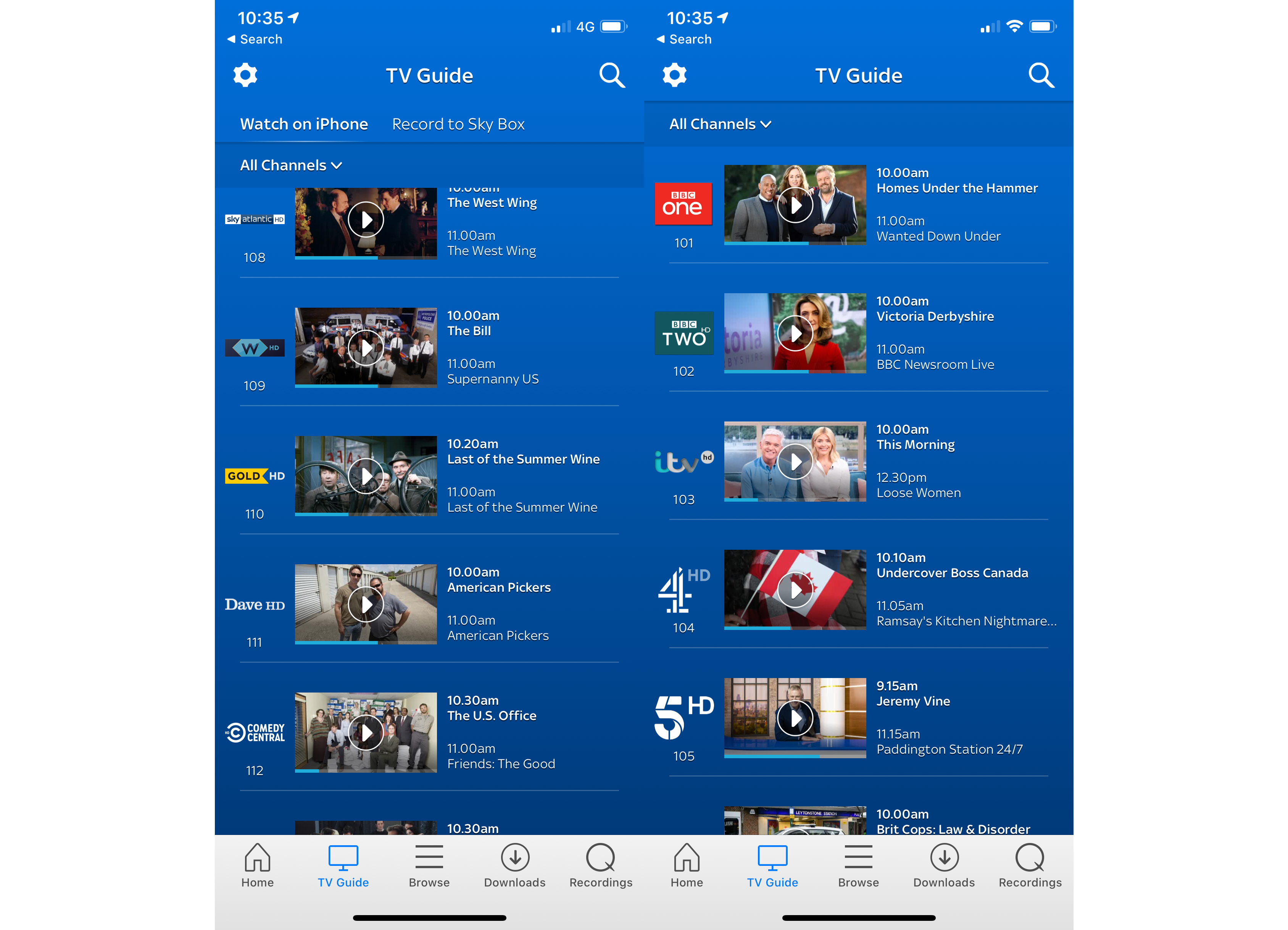
Interface
- Large, bold and easy to navigate
- A few little irritations
Sky has long been the master of the user interface, and Sky Q shows the competition how it should be done. Designed for HD and 4K TVs, the interface is built to take advantage of the full width and resolution of the screen, starting with a live preview of what you’re watching on the left, with the menu options below. Whether you want to view your Recordings, browse the TV Guide or find on-demand content, the intuitive menu system makes it easy, with clean text descriptions and lots of thumbnail images.
For each menu option (TV Guide, Recordings, Catch Up TV, and so on), you can select one and press right on the remote control to bring up sub-menus, such as viewing categories of TV programmes in the guide (sports, news, and so on).
I do have a couple of minor complaints with the interface. There’s a button on the remote that looks like a back button, but it’s called Dismiss and pressing it shuts down the main menu and dumps you back on the full-screen live channel. I’ve had Sky Q since launch and still regularly hit this button by mistake.
There’s also no on-screen help to provide shortcuts for navigating, such as jumping forward or back 24 hours in the TV Guide. Fortunately, our Sky Q tips, tricks and secrets article helps with this.
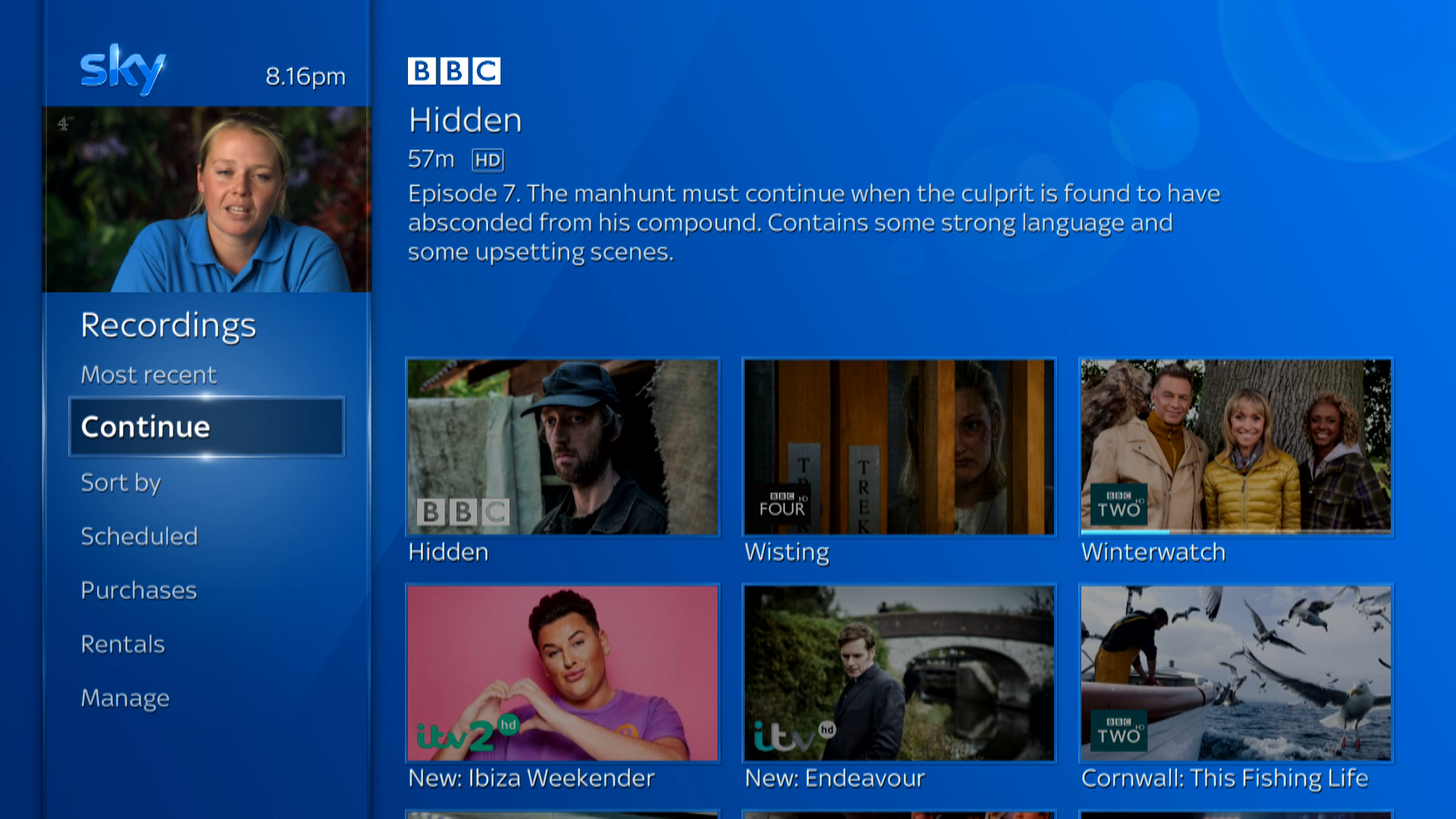
With its most recent interface update, Sky has also taken a small step back in some areas. Go to Recordings now and as soon as you move away from the side-bar menu, the preview screen disappears. You still get audio, but you can’t see what’s happening on TV, which is annoying as you can no longer manage recordings and keep watching.
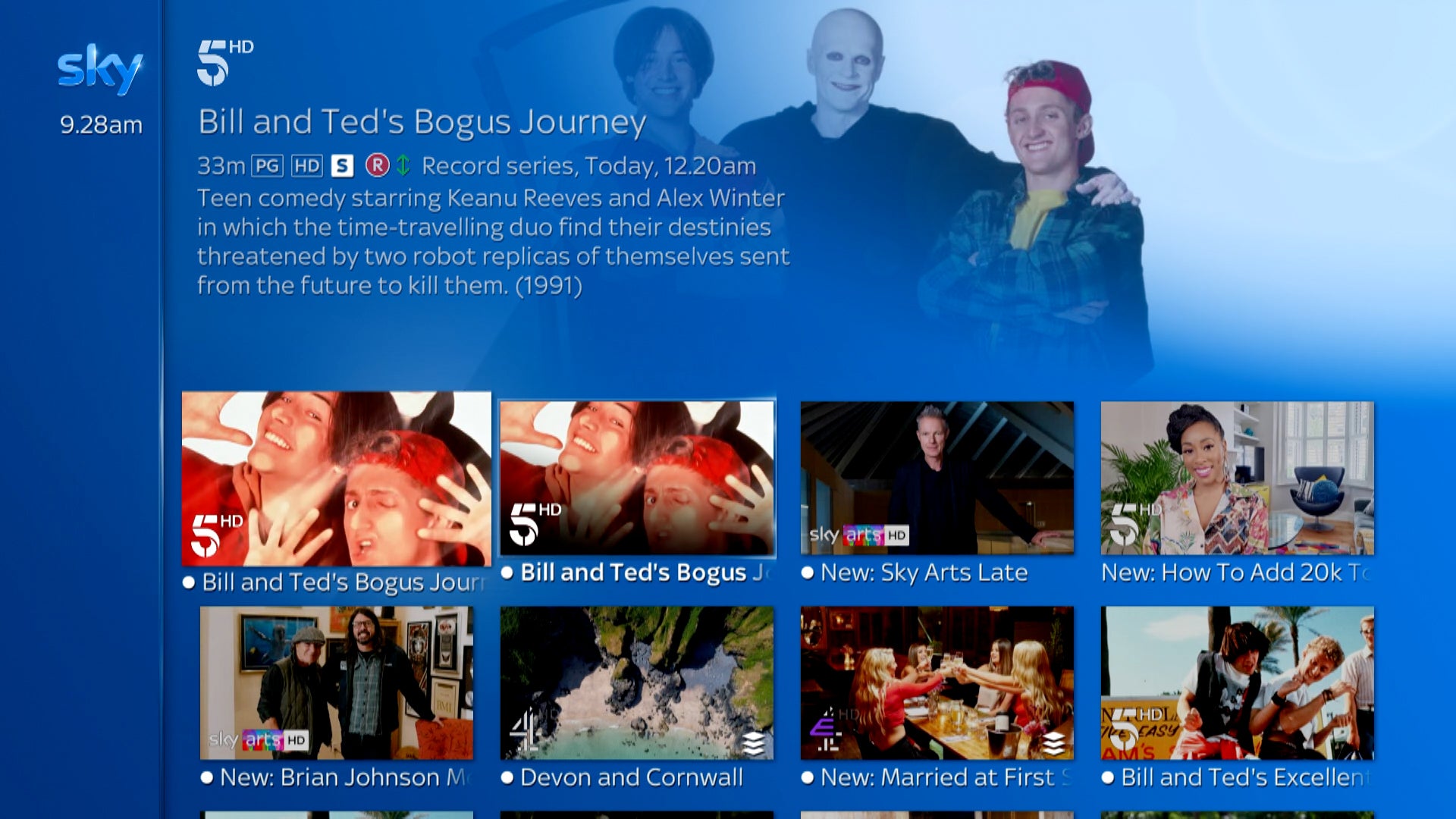
When you have multiple episodes stacked together, there’s a new page for these, too. The next episode (or the one you need to continue) is highlighted at the top with other episodes listed below. There’s a handy submenu to browse more episodes by Recordings, Watch now and On this week. This all works well until you finish an episode. Now, when you go back to this menu, the highlighted item is the next episode to watch, not the one you’ve just finished. It’s not entirely clear, and I’ve almost deleted the wrong episode on several occasions. Now, when you want to delete the episode that you’ve just finished, you have to navigate down the list, find the old episode and delete it there. It’s unnecessarily confusing and adds extra steps to what should be a simple job.
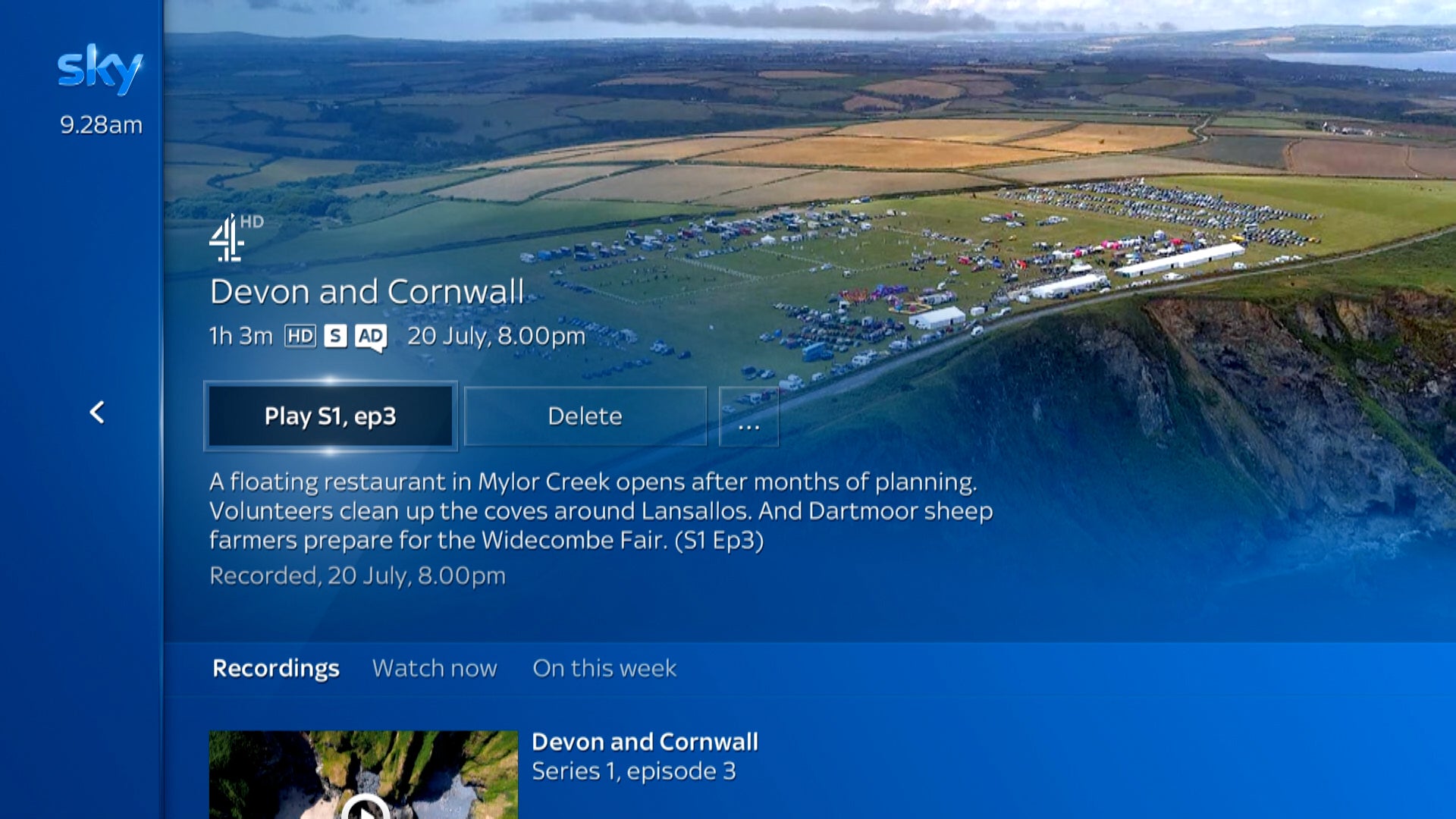
The Sky Q experience breaks down a little with Ultra HD content, too, since you can only watch this on the main box; you can’t select or continue it on a Mini box. When I’ve been watching in Ultra HD and want to continue on a Mini box, I’ve had to download the HD version and fast-forward to the point where I left off.
With Sky Glass and Sky Stream, things are easier. When you continue watching on another device, it just works, streaming in the best quality that’s available.
I am a fan of the universal search function, however. It lets you find a TV show or film from anywhere in your content: live TV, recordings, on-demand and even on Netflix (but not other streaming services). Search is even easier to use with the voice remote, which means you can just say what you want to find without having to type anything in.
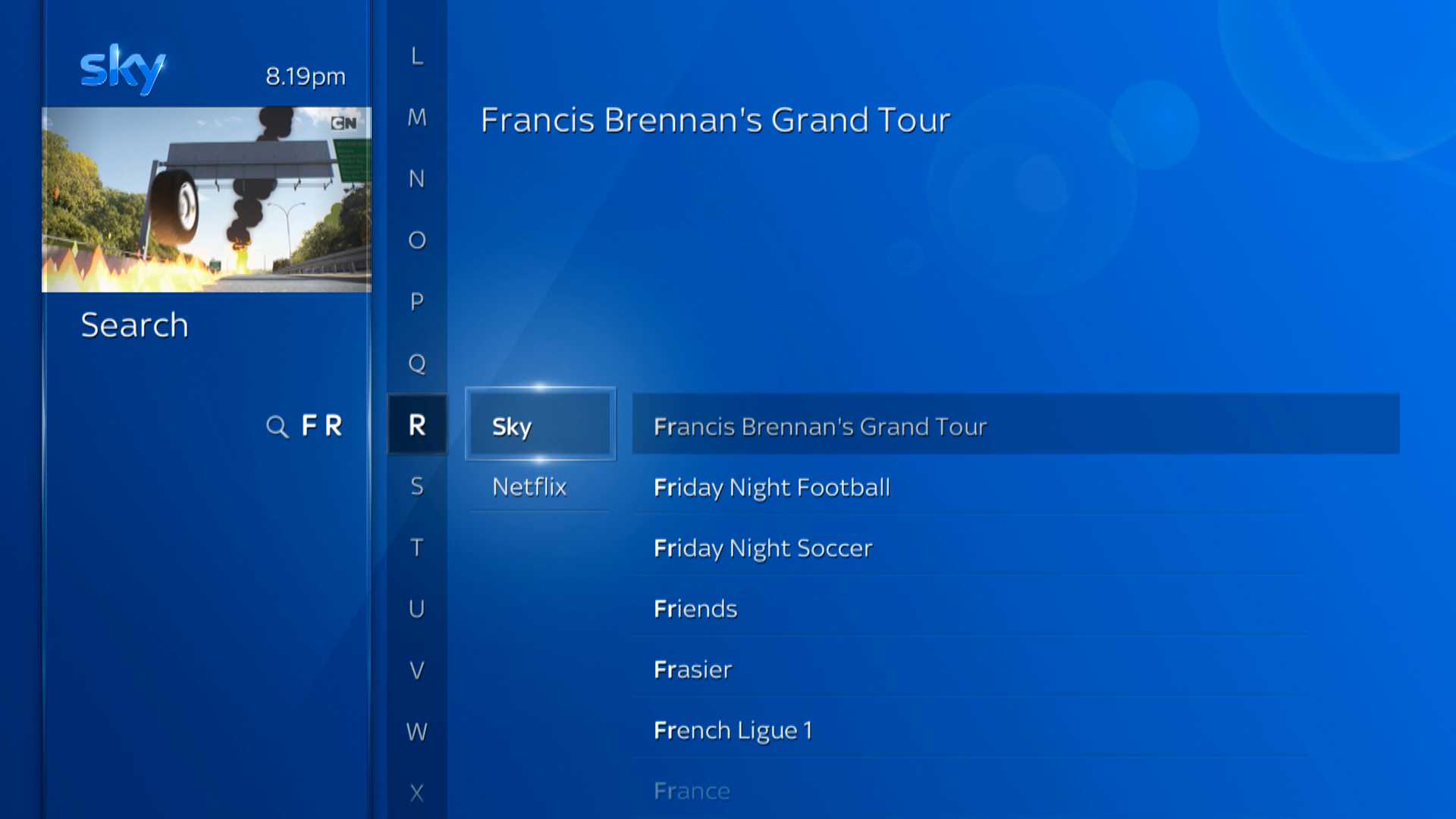
It’s worth mentioning that anything you record from live TV can be stored and kept for as long as you want. If you’re a hoarder of TV and watch months after something was on live, then this makes Sky Q the right choice for you. Streaming TV has an expiry date on it, so shows can disappear before you have time to watch them.
Remotes
- An improvement over the touch remote at launch
- Bluetooth on the main remote
The original Sky Q Touch remote was one of the most divisive parts of the system, abandoning physical buttons for a touchpad and touch-sensitive playback controls. Sky has seen sense and replaced this with the new Sky Q Touch remote.
Although it looks the same, it features a physical cursor and playback controls that makes it easier to use than the original. For those who liked the original, Touch mode on the new remote can be enabled in the settings. Do this and the new remote acts like the old one: swiping up and down through the menus, and left and right to go in and out of sub-menus.
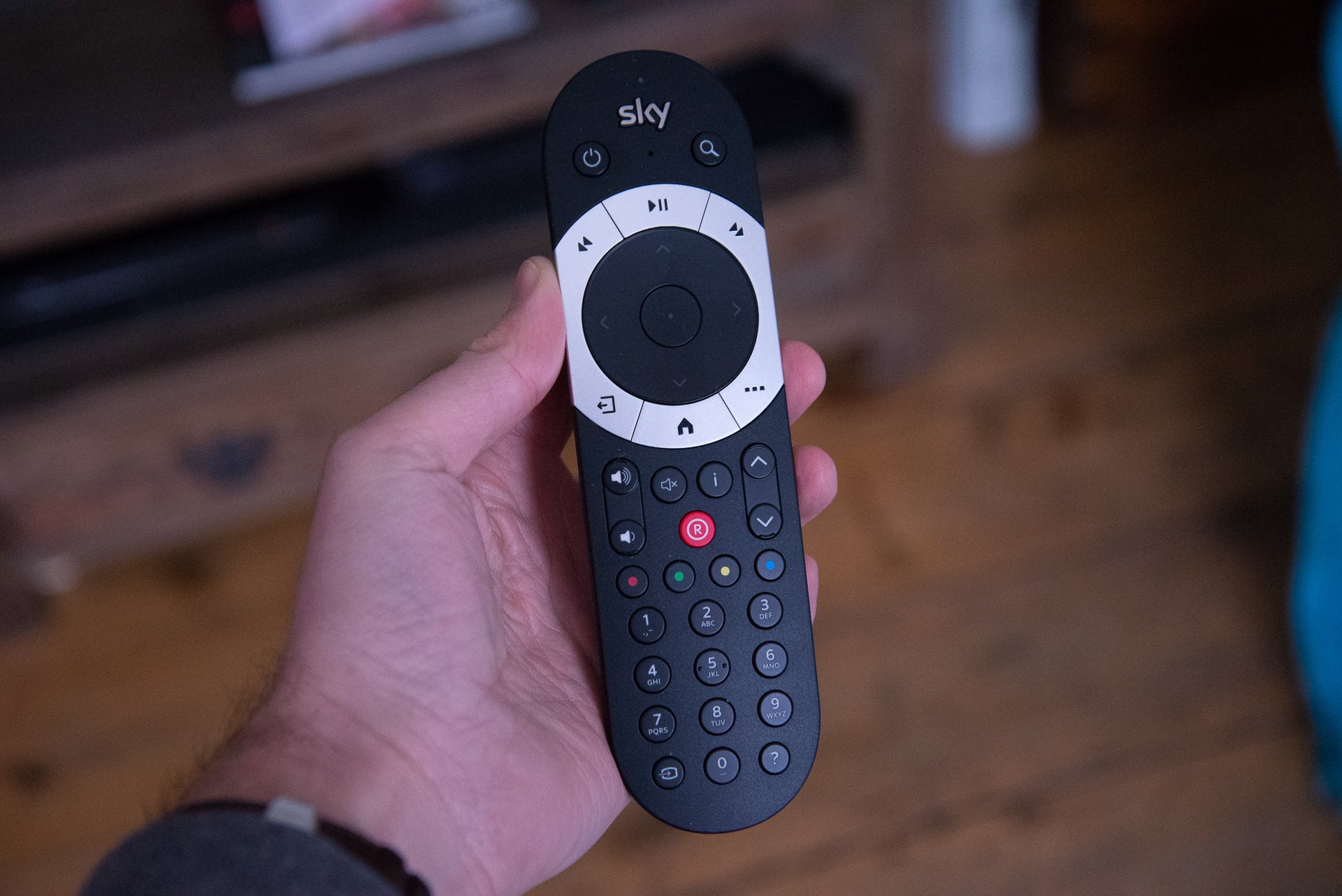
There’s a microphone button on the remote’s side, which you can press and hold to engage voice search or other commands, such as skipping forward five minutes to bypass adverts in a recording.
By default, the Mini boxes ship with standard IR remote controls. They look and feel similar to the main remote, but they need line-of-sight to work and don’t have the microphone button for voice search.
Live channels
- Huge range of options
- Still the best place for Sport
Whether or not a Sky subscription is for you will depend on the type of content you like to watch. What I can say is that the choice of content on offer is simply the best. Thanks to a deal with HBO, Sky Atlantic shows the best from across the pond, including being home to Game of Thrones (now, House of the Dragon) and shows such as The Last of Us.
There’s a new Sky Comedy channel, too, which again features the best shows from the US, including Curb Your Enthusiasm. Films, too, include a plenty of titles as well as premieres you don’t get elsewhere. There’s even a Kids Safe mode to lock down a box so it only shows child-friendly content.
While all of these shows will eventually find their way to other platforms, the fact is you get them first on Sky – and that makes the service worth paying for in my opinion. Sky’s also top when it comes to sports content. While BT and Amazon have nabbed some football and Champions League, you get more Premier League action on Sky, plus Formula One. And, a lot is shown in Ultra HD, too.
Of course, this is a benefit that hits Sky Q only: the same range of channels and options are available on Sky Glass and Sky Stream, too.
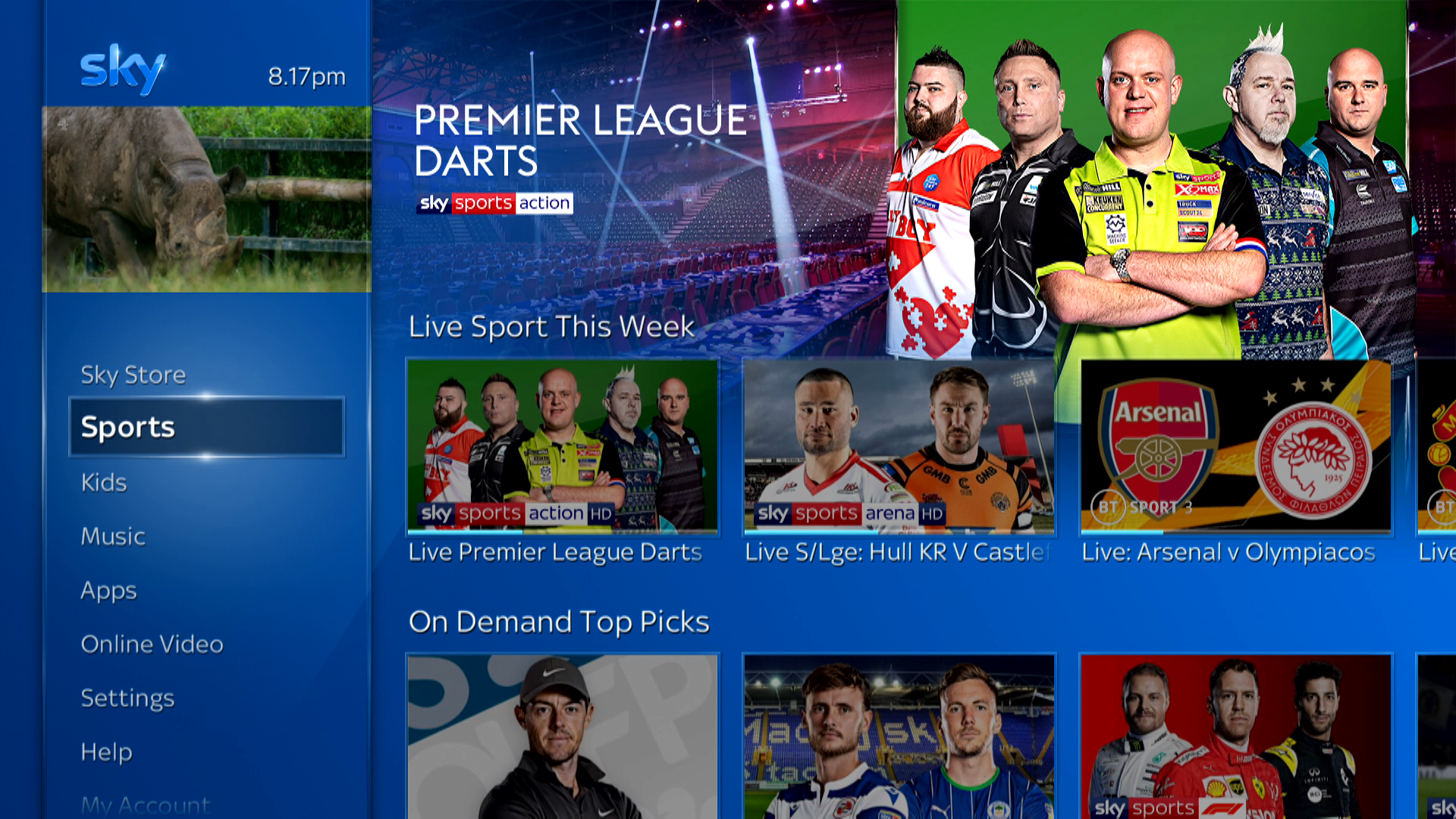
Beyond content that you can watch for “free”, you can rent or even buy films in the Sky Store. Prices vary depending on the title, but you get a good selection that keeps up with iTunes and other streaming services.
Sky has one feature the competition doesn’t, though: you can buy a film and download it immediately – and, depending on how much you pay, you can get a physical copy on DVD or Blu-ray (sadly, there’s no Ultra HD Blu-ray option).
You’ll probably end up paying a couple of quid more than if you were buying online, but you get your film instantly and you get a backup. So, even if you cancel your Sky subscription, you can still watch your film. Given the worry over digital libraries shutting down, Sky Q’s physical discs are a sensible alternative. If you want the best of TV, film and sport, available soonest, Sky is the place to be.
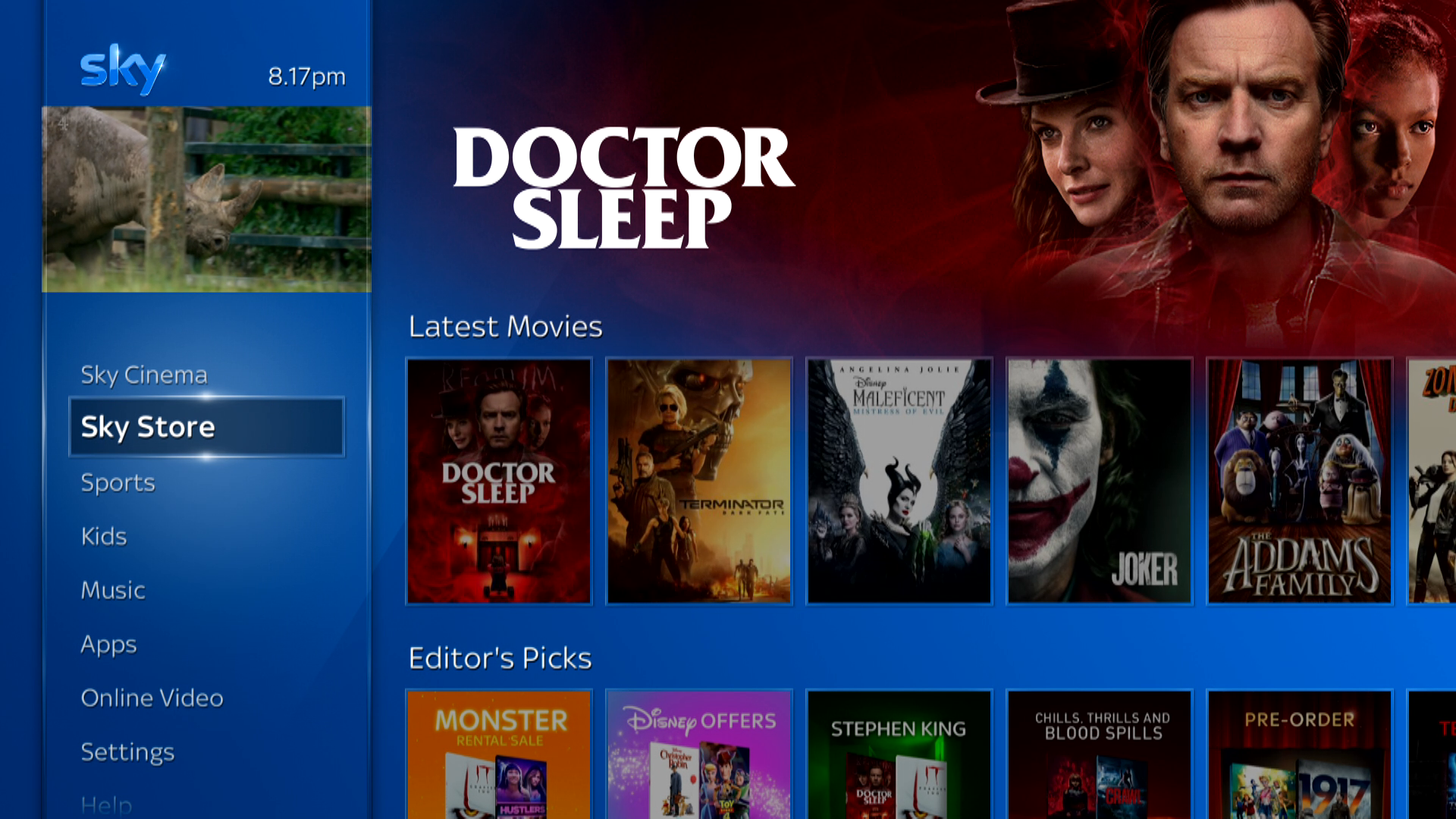
On-demand
- Lots of on-demand content from across all channels
- Content is downloaded not streamed
Beyond live channels, there’s catch-up content for practically every channel plus, depending on your subscription, thousands of boxsets to binge through. Rather than streaming, content is physically downloaded at broadcast quality to your main box.
This method has several advantages over streaming. First, everything is in one place (Recordings section), so you can line up shows to watch by downloading them; it’s a far superior option to a watchlist or favourites, and lets you mix live TV with downloaded shows.
Second, the speed of your broadband becomes largely irrelevant: it may take longer to download on a slow connection, but the quality of the content is the same as someone on a fast connection.
In some cases, on-demand is the best way to watch, too. For example, House of the Dragon and The Last of Us are only available in Ultra HD if you download them; the regular broadcast versions are in HD only.
Note that not all Ultra HD versions are available: Blue Planet II wasn’t available in Ultra HD via the Sky on-demand system, only via iPlayer.
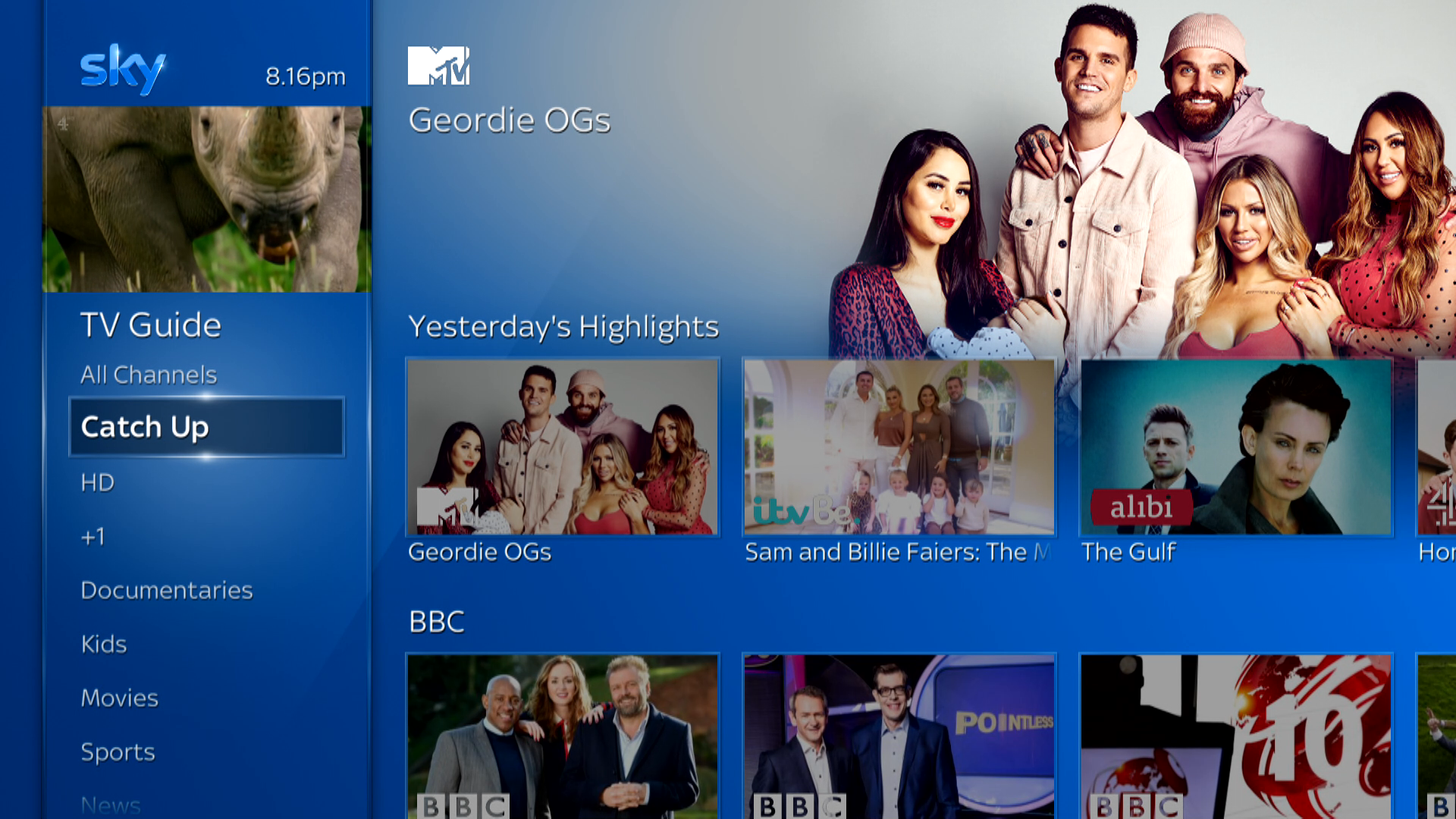
Apps
- Netflix, iPlayer, Disney+, Apple TV+, Paramount+, YouTube and Spotify
- Can’t save streaming content into a watchlist
One of the biggest success stories of Sky Q is that content isn’t limited to Sky itself; the platform supports a growing number of apps. At launch, this was limited to YouTube, but the platform has grown since then.
Netflix has the best integration, and can be included as part of your Sky package, giving you one bill to pay that works out at great value when compared to paying for the two services separately. Netflix can be launched as a standalone app, so you’ll see the same interface you would if launching the app from any other device.
Sky has been smarter still with its implementation, pulling Netflix content into the main Sky Q interface. Select Netflix in the On Demand section, for example, and you get the option to keep watching your most recent shows and a list of trending programmes; select any to fire up the Netflix app and start watching.
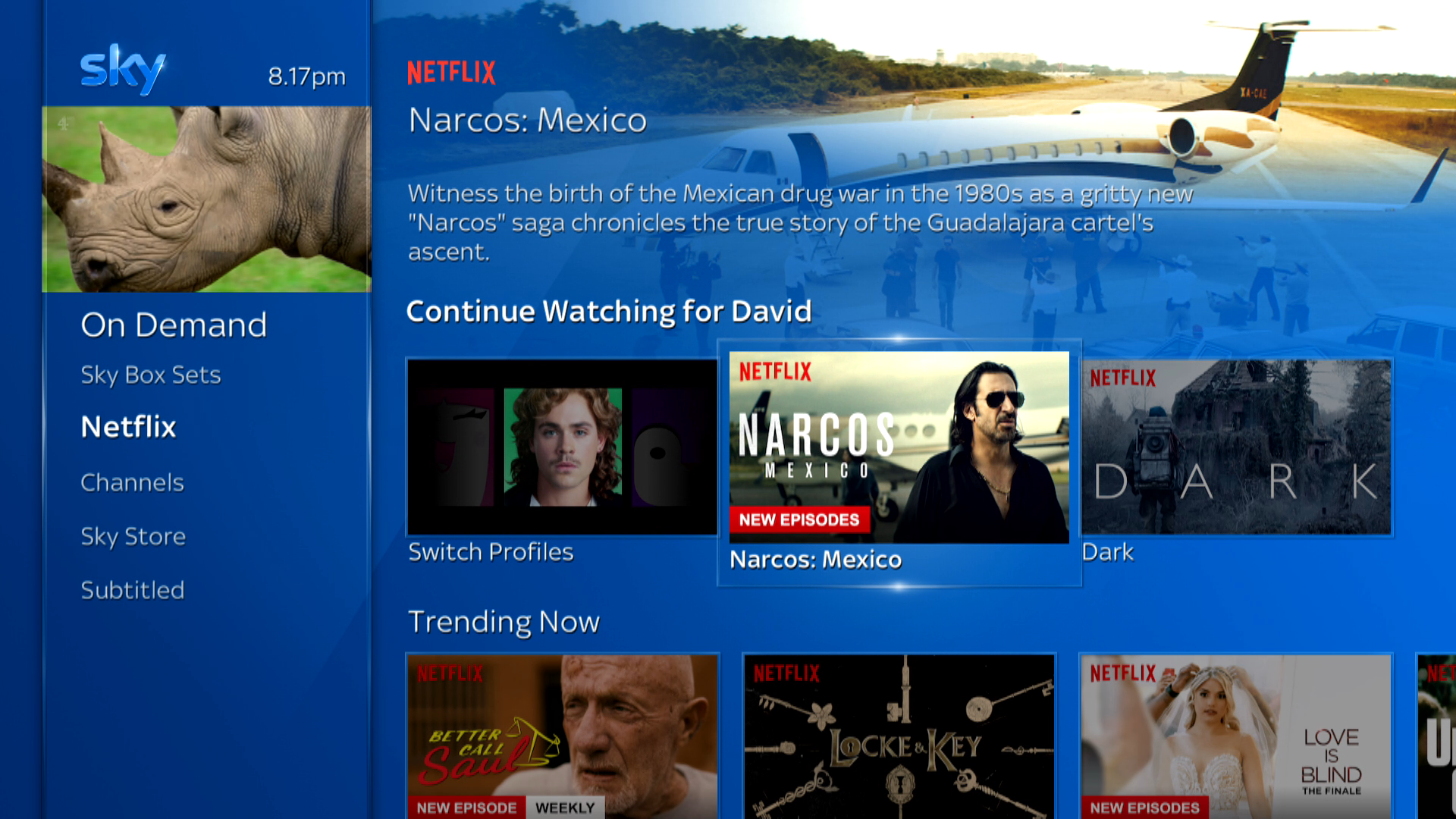
Netflix content also appears in search and in the Continue section. Even better, it works on all of your Sky Q boxes (regular and Mini), so you can watch from anywhere.
Sky has other apps, too. The BBC iPlayer app was added a few years ago. It may seem a bit pointless given that BBC content is available in the on-demand section, but iPlayer brings a wider range of programmes and lets you select different versions of on-demand content, such as watching a regular broadcast rather than the sign-language version. It’s a useful backup, but the main on-demand section offers better quality content.
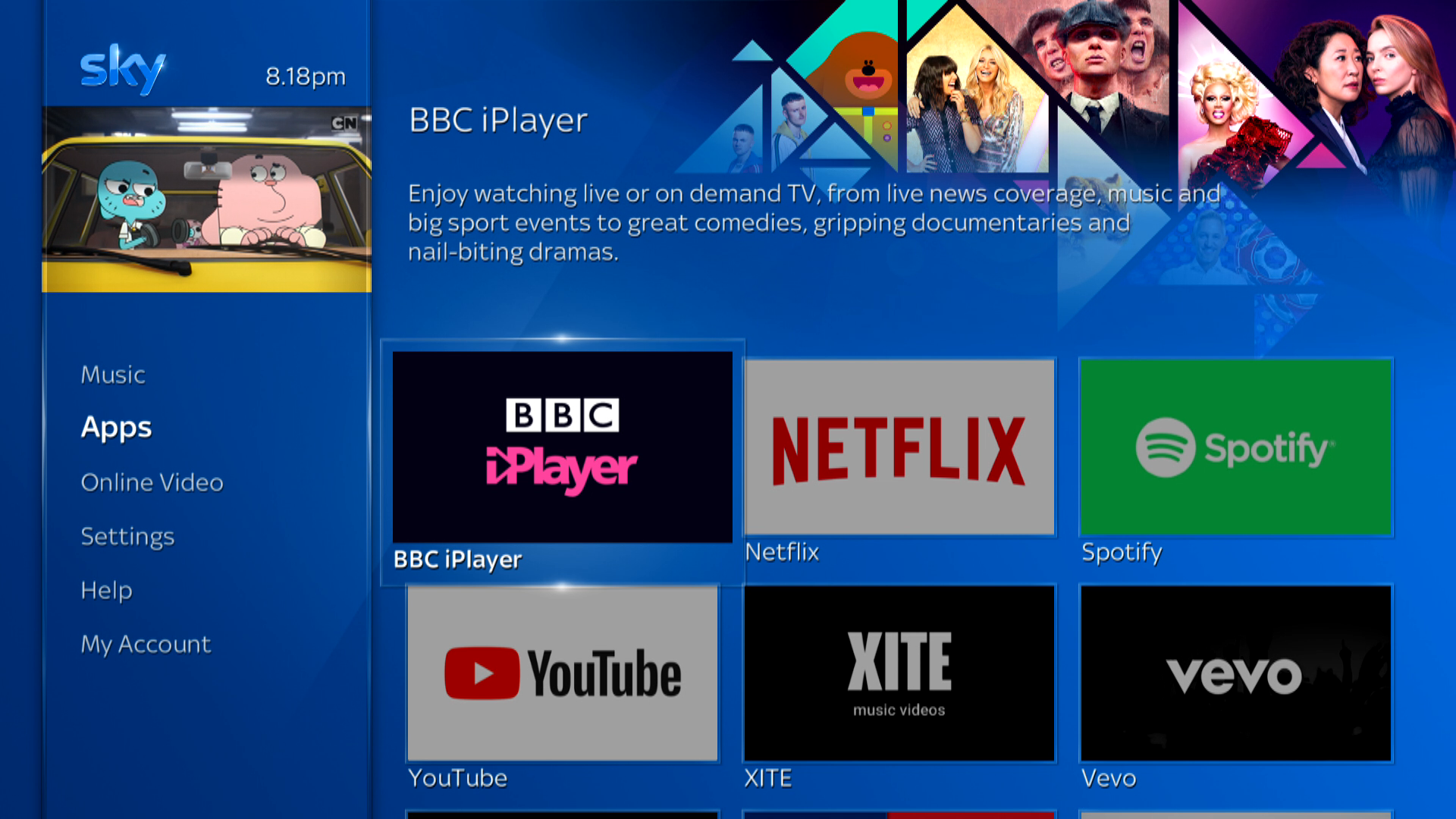
You get access to Spotify, too, so you can play all of your favourite tracks through your TV or sound system. This is handy if you want access to your favourite tunes in the living room but don’t want to buy a new wireless speaker.
Disney+ is a welcome addition, now available in 4K and with HDR. Unlike Netflix, the Disney+ integration is just an app, so you won’t see Disney titles popping up in the main Sky Q interface just yet. Still, having everything on one box can be handy and may mean you can cut down on the number of media streamers you have around the house.
Likewise, Paramount+ (free to Sky Cinema subscribers), Apple TV+ and Amazon Prime Video are all now available as separate apps, but content doesn’t appear in search.
There’s also no way to add programmes from streaming services to a combined watchlist. On that front, Sky Glass and Sky Stream are much better, as they let you build a watch list from all services.
Picture quality
- Great clarity, and now with HDR
Sky runs the full gamut between SD, HD and Ultra HD. SD channels are variable in quality, but Sky has a large range of HD channels, presented in sharp detail. For 4K Ultra HD Content you have to watch via the main Sky Q box, and can view Sky programmes and those on Netflix.
Sky has a huge amount of HD content (the largest in the UK), all of which is sharp, bright and detailed. It also offers the greatest choice of live Ultra HD content, with additional shows and films available via the on-demand section.
For live Ultra HD content, satellite proves its worth, with the ability to stream high bit-rate content without the need for a super-fast internet connection. Watch football in Ultra HD and you’re unlikely to want to return to HD, with the ball easier to see and more detail on the pitch bringing a fantastic clarity.
Films in Ultra HD look superb, too. Picture quality surpasses Netflix, but lags behind physical Ultra HD Blu-ray, which is mastered at higher frame rates. Yet, for all the detail that Ultra HD brings, it’s only recently that Sky has added HDR. Long promised, since launch, HDR has finally made it to the platform, but only for people with newer Sky Q boxes. Our guide on how to get HDR on Sky Q explains more, but for some existing customers, they have to choose whether or not to upgrade their existing box and lose all of their recordings.
Sky uses HLG for HDR, which doesn’t require any additional metadata, so is easier to implement for broadcast TV; and the standard is backwards compatible with SDR TVs, which is great for compatibility. HLG is not as accomplished as Dolby Vision, which has dynamic metadata that means that each shot/frame can be tweaked by the filmmaker to look its best in HDR.
That said, Sky’s HDR content looks great and is a step up from SDR. There’s not a lot of content currently available at the moment, but Gangs of Lemur Island, a nature documentary, has the bright, popping visuals that jump out. With more content on the way, HDR is the missing piece of the Sky Q puzzle. To find HDR content, the easiest way is to use the voice remote and search for HDR.
An upgrade to HDR also means that supported apps can show content in HDR, but not in Dolby Vision. Comparing Disney+ on Sky Q to the native app on my LG OLED TV (this supports Dolby Vision), and there are some subtle difference. While Sky Q delivers the brighter visuals and wider dynamic range, the effect isn’t quite as subtle. Watching the end of The Mandalorian, and the sun in the background is bright and dazzling on Sky Q, but it lacks the subtle levels of detail that the Dolby Vision version produced.
Dolby Atmos support is available on the main box, delivered via Dolby Digital Plus, the same standard used by Netflix. This is compatible with all modern soundbar and AV receivers, such as the Sonos Arc. However, support is limited to Sky content only. Start up the Netflix or Disney+ apps, and you only get the option for 5.1 sound, which is a touch disappointing.
Sky doesn’t have a huge amount of Atmos content, but you can find the range of programmes and films by using the voice remote to search for Dolby Atmos. Where there is support, such as in the film A Star is Born, Atmos makes a huge difference. Just watch the opening scene of that film, and the concert and music fills the room around and above you, making you feel like you were there.
Ultimately, if you want the best streaming quality, then Sky Glass and Sky Stream are a better fit than Sky Q.
Price
- It isn’t cheap, but there’s value in the content
There’s no denying that a Sky Q subscription can be a hefty addition to your monthly outgoings, and it’s more expensive than Sky Stream.
It’s hard to give a concrete number on what it will cost, as Sky is constantly offering deals and price reductions throughout the year. What I can give you is a general overview of the price.
I’m sticking with the Multiroom packages. The base Multiroom package, which includes a 1TB Sky Q box plus a Mini box and some Ultra HD channels (depending on package choice), costs £48 a month with a one-off £20 fee. Ultra HD + HD costs another £12 a month.
To get the premium content, you need to add in extra channels. If you want Sky Sports, it’s usually at a cost of £32 a month – but this includes all of the channels in HD, with Ultra HD available if you’ have the right set-top box. BT Sport can be added, too, for a fairly hefty £28 a month.
Sky Cinema gets you 1000+ on-demand movies (including some Ultra HD) for £19 a month. If you want additional Mini boxes, you’ll need to phone up and get a price for them based on the package you’re taking.
Should you buy Sky Q?
Sky Q used to be the clear leader, but for most people that’s no longer the case. Sky Stream is cheaper per month and each box delivers Ultra HD quality, all without the need for a satellite dish. It’s got the newer interface, letting you build a watchlist from all streaming services, not just Sky channels. If you want the best in sport and US shows, then Sky Stream is a better choice.
That doesn’t mean that Sky Q is completely dead. If you have poor broadband, then Sky Q will still suit you better. And, if you like to record lots of TV and watch when you want, the lack of an expiry date works much better.
Verdict
Technically it’s still the most advanced TV platform on the planet, but in a world of streaming, the newer Sky Stream or Sky Glass platforms may make more sense to most people. That said, the internet-free delivery, ability to record and store programmes for as long as you want, and the same great range of content can make Sky Q the right system for some people.
Pros
- Watch practically everything anywhere
- Powerful interface
- Recordings can be kept forever
- Lots of Ultra HD content
- HDR and Dolby Atmos
Cons
- Not cheap
- HDR support limited
- Dolby Atmos doesn’t work in apps
- Requires a satellite dish
Key Specifications
- Multi-room requires a Sky Q main box and one Sky Q Mini box
- Supports up to two simultaneous Sky Q Mini boxes and two mobile devices
- Ultra HD resolution (Sky Q), Full HD resolution (Sky Q Mini)
- Netflix, YouTube, BBC iPlayer and Spotify apps
Launched back in 2016, Sky Q was the company’s answer to the new-wave of streaming services, spearheaded by Netflix. Taking everything great about Sky TV, the company built a new multi-room system, so you could watch your live and recorded shows anywhere in the house, both on other TVs and on your phone.
Since it launched, faster internet speeds enabling higher-quality streaming services has seen Sky Q come under fire to the point that the latest products, Sky Glass and Sky Stream, ditch the need for a satellite dish completely. Offering more flexibility and a more straightforward installation, the new Sky services are probably a better fit for most people.
Yet, there are still some of us that can do with Sky Q: its main TV doesn’t need a broadband connection, it’s on-demand services can deliver 4K UHD regardless of internet speed, and it can store recorded programmes for as long as you like. Here’s what you want to know.
Design and boxes
- Your TV service where you want it
- Only the main box provides 4K
Although Sky Q can work on a single TV, the system really shows its worth when you opt for the Multiroom package, which is the focus of this review.
These packages begin with the main box, which acts as the hub for your system. As standard you get a 1TB box, but a larger, 2TB model is available for those who see themselves recording and downloading a tonne of content – although you’ll need to talk to a Sky Advisor to order one.
More than six years on since launch and the Sky Q box design remains impressive. Smooth curves and a simple front result in a box that looks great, but doesn’t draw too much attention. Compare it to the Virgin V6 box, which looks like a relic from the 1980s, and Sky has a clear design lead.
Boxes are still chunky compared to the more modern Stream device: there’s not much Sky can do about this, as it has to squeeze in satellite tuners and a hard disk.

Sky Q really shows its worth when you add in extra devices, including Mini boxes that you plug into other TVs in your home. These stream live channels, on-demand TV and recordings from your main box, giving you access to your full Sky Q package from around your home. You can have up to two Mini boxes working simultaneously, although if you want more than one, then you’ll have to phone up to order.
Each Mini is a relatively small and neat-looking box. While the main Sky Q box is 4K compatible, the Mini boxes are HD-only. With faster wireless available today than when Sky Q first launched, I’d like to see Ultra HD Mini boxes – but it seems unlikely that we’ll get this, given that the main focus is now the new streaming services.

Beyond the physical boxes, you can use the Sky Go app on your phone or tablet. Provided your device is on the same network as your main Sky Q box, you can stream live channels, on-demand programmes and even download recordings from Sky channels (those bar BBC, ITV, and so on) for offline watching. Up to two mobile devices can be connected at the same time, in addition to two Mini boxes. Outside of your home network Sky Go works as normal, giving you live TV streaming (Sky channels online outside your home) and access to on-demand content.

Interface
- Large, bold and easy to navigate
- A few little irritations
Sky has long been the master of the user interface, and Sky Q shows the competition how it should be done. Designed for HD and 4K TVs, the interface is built to take advantage of the full width and resolution of the screen, starting with a live preview of what you’re watching on the left, with the menu options below. Whether you want to view your Recordings, browse the TV Guide or find on-demand content, the intuitive menu system makes it easy, with clean text descriptions and lots of thumbnail images.
For each menu option (TV Guide, Recordings, Catch Up TV, and so on), you can select one and press right on the remote control to bring up sub-menus, such as viewing categories of TV programmes in the guide (sports, news, and so on).
I do have a couple of minor complaints with the interface. There’s a button on the remote that looks like a back button, but it’s called Dismiss and pressing it shuts down the main menu and dumps you back on the full-screen live channel. I’ve had Sky Q since launch and still regularly hit this button by mistake.
There’s also no on-screen help to provide shortcuts for navigating, such as jumping forward or back 24 hours in the TV Guide. Fortunately, our Sky Q tips, tricks and secrets article helps with this.

With its most recent interface update, Sky has also taken a small step back in some areas. Go to Recordings now and as soon as you move away from the side-bar menu, the preview screen disappears. You still get audio, but you can’t see what’s happening on TV, which is annoying as you can no longer manage recordings and keep watching.

When you have multiple episodes stacked together, there’s a new page for these, too. The next episode (or the one you need to continue) is highlighted at the top with other episodes listed below. There’s a handy submenu to browse more episodes by Recordings, Watch now and On this week. This all works well until you finish an episode. Now, when you go back to this menu, the highlighted item is the next episode to watch, not the one you’ve just finished. It’s not entirely clear, and I’ve almost deleted the wrong episode on several occasions. Now, when you want to delete the episode that you’ve just finished, you have to navigate down the list, find the old episode and delete it there. It’s unnecessarily confusing and adds extra steps to what should be a simple job.

The Sky Q experience breaks down a little with Ultra HD content, too, since you can only watch this on the main box; you can’t select or continue it on a Mini box. When I’ve been watching in Ultra HD and want to continue on a Mini box, I’ve had to download the HD version and fast-forward to the point where I left off.
With Sky Glass and Sky Stream, things are easier. When you continue watching on another device, it just works, streaming in the best quality that’s available.
I am a fan of the universal search function, however. It lets you find a TV show or film from anywhere in your content: live TV, recordings, on-demand and even on Netflix (but not other streaming services). Search is even easier to use with the voice remote, which means you can just say what you want to find without having to type anything in.

It’s worth mentioning that anything you record from live TV can be stored and kept for as long as you want. If you’re a hoarder of TV and watch months after something was on live, then this makes Sky Q the right choice for you. Streaming TV has an expiry date on it, so shows can disappear before you have time to watch them.
Remotes
- An improvement over the touch remote at launch
- Bluetooth on the main remote
The original Sky Q Touch remote was one of the most divisive parts of the system, abandoning physical buttons for a touchpad and touch-sensitive playback controls. Sky has seen sense and replaced this with the new Sky Q Touch remote.
Although it looks the same, it features a physical cursor and playback controls that makes it easier to use than the original. For those who liked the original, Touch mode on the new remote can be enabled in the settings. Do this and the new remote acts like the old one: swiping up and down through the menus, and left and right to go in and out of sub-menus.

There’s a microphone button on the remote’s side, which you can press and hold to engage voice search or other commands, such as skipping forward five minutes to bypass adverts in a recording.
By default, the Mini boxes ship with standard IR remote controls. They look and feel similar to the main remote, but they need line-of-sight to work and don’t have the microphone button for voice search.
Live channels
- Huge range of options
- Still the best place for Sport
Whether or not a Sky subscription is for you will depend on the type of content you like to watch. What I can say is that the choice of content on offer is simply the best. Thanks to a deal with HBO, Sky Atlantic shows the best from across the pond, including being home to Game of Thrones (now, House of the Dragon) and shows such as The Last of Us.
There’s a new Sky Comedy channel, too, which again features the best shows from the US, including Curb Your Enthusiasm. Films, too, include a plenty of titles as well as premieres you don’t get elsewhere. There’s even a Kids Safe mode to lock down a box so it only shows child-friendly content.
While all of these shows will eventually find their way to other platforms, the fact is you get them first on Sky – and that makes the service worth paying for in my opinion. Sky’s also top when it comes to sports content. While BT and Amazon have nabbed some football and Champions League, you get more Premier League action on Sky, plus Formula One. And, a lot is shown in Ultra HD, too.
Of course, this is a benefit that hits Sky Q only: the same range of channels and options are available on Sky Glass and Sky Stream, too.

Beyond content that you can watch for “free”, you can rent or even buy films in the Sky Store. Prices vary depending on the title, but you get a good selection that keeps up with iTunes and other streaming services.
Sky has one feature the competition doesn’t, though: you can buy a film and download it immediately – and, depending on how much you pay, you can get a physical copy on DVD or Blu-ray (sadly, there’s no Ultra HD Blu-ray option).
You’ll probably end up paying a couple of quid more than if you were buying online, but you get your film instantly and you get a backup. So, even if you cancel your Sky subscription, you can still watch your film. Given the worry over digital libraries shutting down, Sky Q’s physical discs are a sensible alternative. If you want the best of TV, film and sport, available soonest, Sky is the place to be.

On-demand
- Lots of on-demand content from across all channels
- Content is downloaded not streamed
Beyond live channels, there’s catch-up content for practically every channel plus, depending on your subscription, thousands of boxsets to binge through. Rather than streaming, content is physically downloaded at broadcast quality to your main box.
This method has several advantages over streaming. First, everything is in one place (Recordings section), so you can line up shows to watch by downloading them; it’s a far superior option to a watchlist or favourites, and lets you mix live TV with downloaded shows.
Second, the speed of your broadband becomes largely irrelevant: it may take longer to download on a slow connection, but the quality of the content is the same as someone on a fast connection.
In some cases, on-demand is the best way to watch, too. For example, House of the Dragon and The Last of Us are only available in Ultra HD if you download them; the regular broadcast versions are in HD only.
Note that not all Ultra HD versions are available: Blue Planet II wasn’t available in Ultra HD via the Sky on-demand system, only via iPlayer.

Apps
- Netflix, iPlayer, Disney+, Apple TV+, Paramount+, YouTube and Spotify
- Can’t save streaming content into a watchlist
One of the biggest success stories of Sky Q is that content isn’t limited to Sky itself; the platform supports a growing number of apps. At launch, this was limited to YouTube, but the platform has grown since then.
Netflix has the best integration, and can be included as part of your Sky package, giving you one bill to pay that works out at great value when compared to paying for the two services separately. Netflix can be launched as a standalone app, so you’ll see the same interface you would if launching the app from any other device.
Sky has been smarter still with its implementation, pulling Netflix content into the main Sky Q interface. Select Netflix in the On Demand section, for example, and you get the option to keep watching your most recent shows and a list of trending programmes; select any to fire up the Netflix app and start watching.

Netflix content also appears in search and in the Continue section. Even better, it works on all of your Sky Q boxes (regular and Mini), so you can watch from anywhere.
Sky has other apps, too. The BBC iPlayer app was added a few years ago. It may seem a bit pointless given that BBC content is available in the on-demand section, but iPlayer brings a wider range of programmes and lets you select different versions of on-demand content, such as watching a regular broadcast rather than the sign-language version. It’s a useful backup, but the main on-demand section offers better quality content.

You get access to Spotify, too, so you can play all of your favourite tracks through your TV or sound system. This is handy if you want access to your favourite tunes in the living room but don’t want to buy a new wireless speaker.
Disney+ is a welcome addition, now available in 4K and with HDR. Unlike Netflix, the Disney+ integration is just an app, so you won’t see Disney titles popping up in the main Sky Q interface just yet. Still, having everything on one box can be handy and may mean you can cut down on the number of media streamers you have around the house.
Likewise, Paramount+ (free to Sky Cinema subscribers), Apple TV+ and Amazon Prime Video are all now available as separate apps, but content doesn’t appear in search.
There’s also no way to add programmes from streaming services to a combined watchlist. On that front, Sky Glass and Sky Stream are much better, as they let you build a watch list from all services.
Picture quality
- Great clarity, and now with HDR
Sky runs the full gamut between SD, HD and Ultra HD. SD channels are variable in quality, but Sky has a large range of HD channels, presented in sharp detail. For 4K Ultra HD Content you have to watch via the main Sky Q box, and can view Sky programmes and those on Netflix.
Sky has a huge amount of HD content (the largest in the UK), all of which is sharp, bright and detailed. It also offers the greatest choice of live Ultra HD content, with additional shows and films available via the on-demand section.
For live Ultra HD content, satellite proves its worth, with the ability to stream high bit-rate content without the need for a super-fast internet connection. Watch football in Ultra HD and you’re unlikely to want to return to HD, with the ball easier to see and more detail on the pitch bringing a fantastic clarity.
Films in Ultra HD look superb, too. Picture quality surpasses Netflix, but lags behind physical Ultra HD Blu-ray, which is mastered at higher frame rates. Yet, for all the detail that Ultra HD brings, it’s only recently that Sky has added HDR. Long promised, since launch, HDR has finally made it to the platform, but only for people with newer Sky Q boxes. Our guide on how to get HDR on Sky Q explains more, but for some existing customers, they have to choose whether or not to upgrade their existing box and lose all of their recordings.
Sky uses HLG for HDR, which doesn’t require any additional metadata, so is easier to implement for broadcast TV; and the standard is backwards compatible with SDR TVs, which is great for compatibility. HLG is not as accomplished as Dolby Vision, which has dynamic metadata that means that each shot/frame can be tweaked by the filmmaker to look its best in HDR.
That said, Sky’s HDR content looks great and is a step up from SDR. There’s not a lot of content currently available at the moment, but Gangs of Lemur Island, a nature documentary, has the bright, popping visuals that jump out. With more content on the way, HDR is the missing piece of the Sky Q puzzle. To find HDR content, the easiest way is to use the voice remote and search for HDR.
An upgrade to HDR also means that supported apps can show content in HDR, but not in Dolby Vision. Comparing Disney+ on Sky Q to the native app on my LG OLED TV (this supports Dolby Vision), and there are some subtle difference. While Sky Q delivers the brighter visuals and wider dynamic range, the effect isn’t quite as subtle. Watching the end of The Mandalorian, and the sun in the background is bright and dazzling on Sky Q, but it lacks the subtle levels of detail that the Dolby Vision version produced.
Dolby Atmos support is available on the main box, delivered via Dolby Digital Plus, the same standard used by Netflix. This is compatible with all modern soundbar and AV receivers, such as the Sonos Arc. However, support is limited to Sky content only. Start up the Netflix or Disney+ apps, and you only get the option for 5.1 sound, which is a touch disappointing.
Sky doesn’t have a huge amount of Atmos content, but you can find the range of programmes and films by using the voice remote to search for Dolby Atmos. Where there is support, such as in the film A Star is Born, Atmos makes a huge difference. Just watch the opening scene of that film, and the concert and music fills the room around and above you, making you feel like you were there.
Ultimately, if you want the best streaming quality, then Sky Glass and Sky Stream are a better fit than Sky Q.
Price
- It isn’t cheap, but there’s value in the content
There’s no denying that a Sky Q subscription can be a hefty addition to your monthly outgoings, and it’s more expensive than Sky Stream.
It’s hard to give a concrete number on what it will cost, as Sky is constantly offering deals and price reductions throughout the year. What I can give you is a general overview of the price.
I’m sticking with the Multiroom packages. The base Multiroom package, which includes a 1TB Sky Q box plus a Mini box and some Ultra HD channels (depending on package choice), costs £48 a month with a one-off £20 fee. Ultra HD + HD costs another £12 a month.
To get the premium content, you need to add in extra channels. If you want Sky Sports, it’s usually at a cost of £32 a month – but this includes all of the channels in HD, with Ultra HD available if you’ have the right set-top box. BT Sport can be added, too, for a fairly hefty £28 a month.
Sky Cinema gets you 1000+ on-demand movies (including some Ultra HD) for £19 a month. If you want additional Mini boxes, you’ll need to phone up and get a price for them based on the package you’re taking.
Should you buy Sky Q?
Sky Q used to be the clear leader, but for most people that’s no longer the case. Sky Stream is cheaper per month and each box delivers Ultra HD quality, all without the need for a satellite dish. It’s got the newer interface, letting you build a watchlist from all streaming services, not just Sky channels. If you want the best in sport and US shows, then Sky Stream is a better choice.
That doesn’t mean that Sky Q is completely dead. If you have poor broadband, then Sky Q will still suit you better. And, if you like to record lots of TV and watch when you want, the lack of an expiry date works much better.




